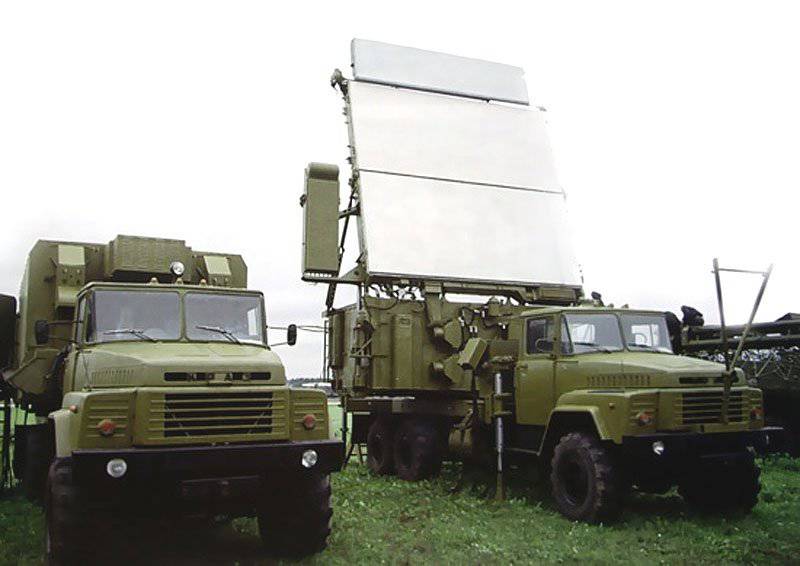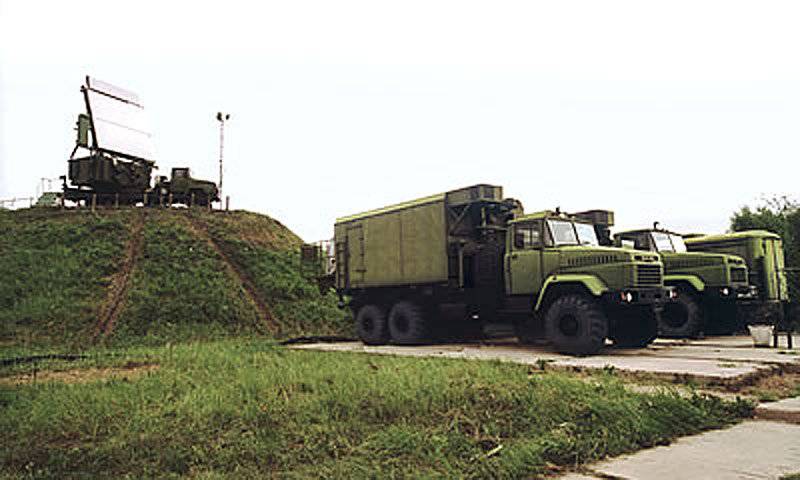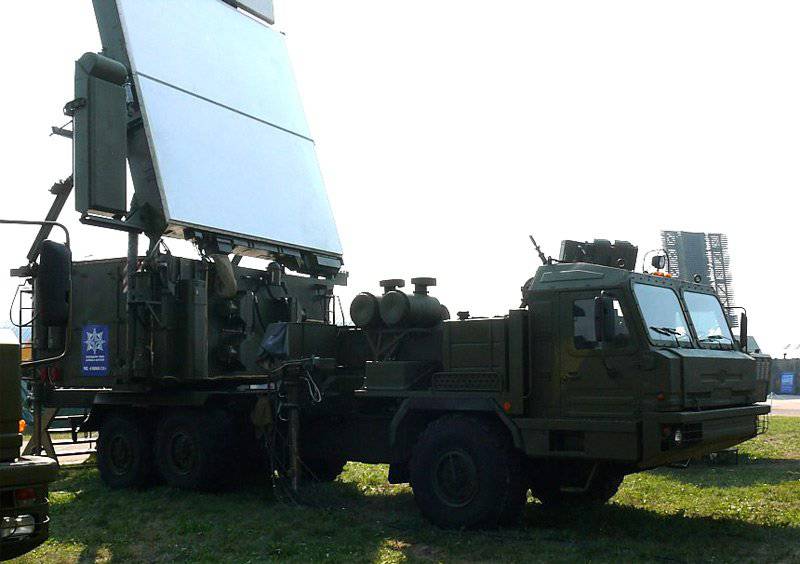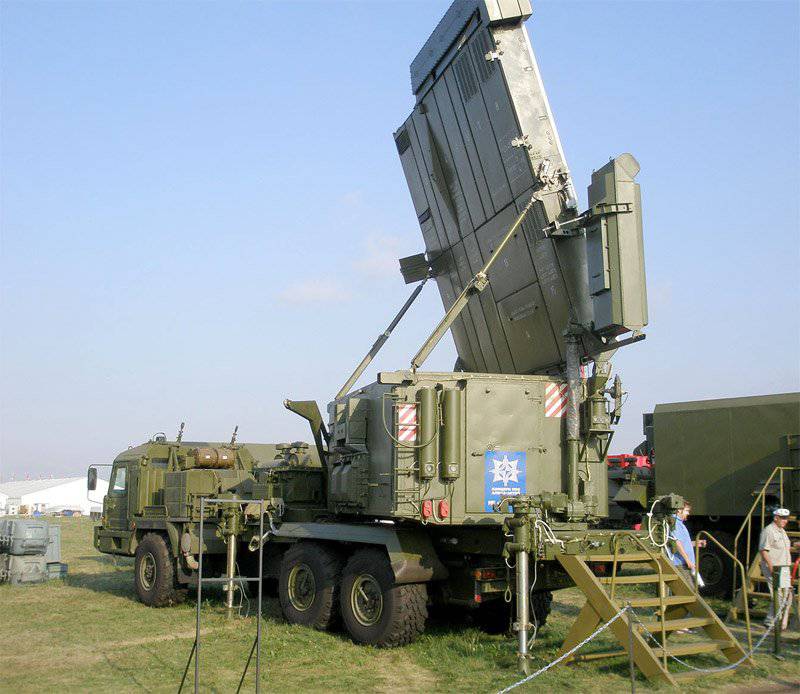Air defense and air force armament - 64L6 mobile radar "Gamma-С1"
- detects and measures the three coordinates of air objects;
- quickly determines the nationality of the detected objects;
- accurately recognizes targets by class;
- determines the goniometric and azimuth bearings on objects of active interference;
- provides digital information to information display devices.

The antenna component of the radar is mounted on an M-1 vehicle and is a flat phased antenna array (PAR), which performs electronic scanning of transmitting and receiving beams according to the radiation pattern in the vertical plane. The implementation of a sequential review allows the radar to control the radiated energy using a software method. The transmitting device uses a modern Russian electrovacuum device - a broadband multipath klystron, which has a high output power and a high degree of reliability. According to the main characteristics it is not inferior to the best world analogues. All equipment "Gamma-С1" has a high automation of the detection of air objects and the choice of operating mode. The mode of operation is selected based on the processed situation data by the operator or automatically.
Digital data processing takes place in the equipment installed on the M2 car. Digital processing equipment provides:
- detection of air objects in the automatic mode;
- tracking or capturing objects in automatic or semi-automatic modes;
- selection of operating modes using automatic or semi-automatic control;
- autodetermination of state property;
- collection and issuance of data on information display devices.

All active and passive interference is suppressed by radar equipment automatically. Radar has a high adaptability and selectivity in terms of setting various types of interference. Such efficiency is ensured by:
- small in power, but a longer in duration emitted pulse;
- low level of side-lobe pattern;
- by changing the frequency of repetitions and the duration of the emitted signal when scanning space by an elevation method;
- auto gain control;
- auto dynamic range;
- stabilization of false alarms;
- work of the equipment of autocompensation with ACP;
- the use of preset modes for protection against special interference;
- application of Doppler type filtering;
The radar has an automated performance monitoring system for continuous diagnostics (95% accuracy) and providing information on the performance of all radar elements. The equipment has a block-modular construction, which facilitates repair - block-by-block replacement of the necessary elements occurs. Modes of operation of the radar can be launched from the sets of means of calculation or at the request of the operator. It is possible to control the radar from a remote secured operator's seat, at a distance of up to 1000 meters via optical fiber and at a distance of up to 15 000 meters along a radio link. The radar is based on car chassis.
The composition of the complex Gamma СХNUMX:
- car M1, equipped with an antenna and a turning device, receiving and transmitting equipment and radio inquiry equipment;
- car M2, equipped with radar control systems, data processing, information display and transmission of received data;
- car М3, with zip, KIA and additional equipment;
- trailers with power supply systems (ES 99X6) cling to cars М1, М2.
Cars М1 and М2 are made on the KrAZ-260Г chassis. The speed of the highway / ground - 50 / 30 km / h.
The main characteristics of the HEADLIGHTS:
- range from 10 to 300 kilometers, special mode to 400 kilometers;
- azimuth review - circular;
- Angle view - from 30 to -2 degrees;
- altitude range - 30 kilometers;
- range accuracy - 50 meters;
- azimuthal accuracy - 15 minutes;
- the accuracy of the elevation angle - 10 -15 minutes;
- accuracy in height - 400 meters;
- range resolution - 250 meters;
- azimuth resolution - 1.4 degrees;
- simultaneously accompanied targets - up to 100 units;
- data refresh rate - 10 seconds;
- output data - coordinate, trace.
Operation possibilities:
- permissible air temperature - ± 50 degrees;
- OVV at an average temperature of up to 98 percent;
- location above sea level to 2 kilometers;
Modifications radar:
- 64Л6 called “Gamma-С1” - the main radar;
- 64Л6Е called “Gamma-С1Е” - the first modification, the layout of the main radar, was created for demonstration performances;
- 64Л6-1 called “Gamma-С1”, the following modification, the main difference is the automobile chassis BAZ-69092-013;

- 64Л6М called “Gamma СХNUMXМ” is the last modification for today. According to sources from the military department of the Russian Federation, it is known about the commissioning of the updated 1 units of these complexes by the Air Force RTV until the end of the 20 year.

The main characteristics of the complex 64Л6-1:
- time to deploy-collapse radar - 40 minutes;
- power supply - industrial or independent;
- guaranteed uptime - 500 hours;
- time to restore work after failure 30 minutes;
- continuity up to 72 hours;
- the inclusion of 5 radar minutes, the possibility of an emergency start in three minutes.
Information